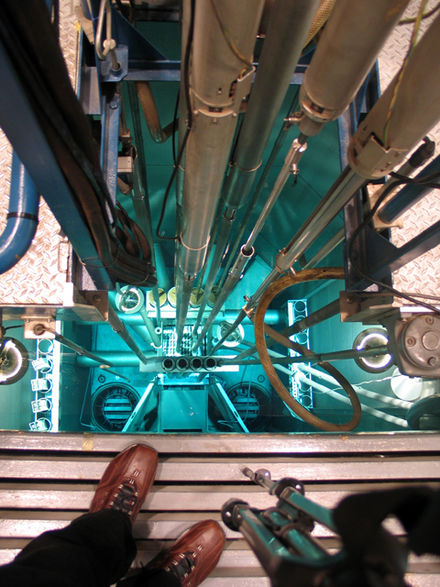
A nuclear reactor, formerly known as an atomic pile, is a device used to initiate and control a self-sustained nuclear chain reaction. Nuclear reactors are used at nuclear power plants for electricity generation and in nuclear marine propulsion. Heat from nuclear fission is passed to a working fluid, which in turn runs through steam turbines. These either drive a ship's propellers or turn electrical generators' shafts. Nuclear generated steam in principle can be used for industrial process heat or for district heating. Some reactors are used to produce isotopes for medical and industrial use, or for production of weapons-grade plutonium. As of early 2019, the IAEA reports there are 454 nuclear power reactors and 226 nuclear research reactors in operation around the world.

A nuclear meltdown is a severe nuclear reactor accident that results in core damage from overheating. The term nuclear meltdown is not officially defined by the International Atomic Energy Agency or by the Nuclear Regulatory Commission. It has been defined to mean the accidental melting of the core of a nuclear reactor, however, and is in common usage a reference to the core's either complete or partial collapse.

The nuclear fuel cycle, also called nuclear fuel chain, is the progression of nuclear fuel through a series of differing stages. It consists of steps in the front end, which are the preparation of the fuel, steps in the service period in which the fuel is used during reactor operation, and steps in the back end, which are necessary to safely manage, contain, and either reprocess or dispose of spent nuclear fuel. If spent fuel is not reprocessed, the fuel cycle is referred to as an open fuel cycle ; if the spent fuel is reprocessed, it is referred to as a closed fuel cycle.
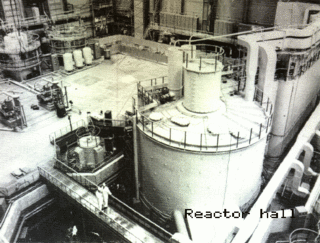
A fast-neutron reactor (FNR) or simply a fast reactor is a category of nuclear reactor in which the fission chain reaction is sustained by fast neutrons, as opposed to thermal neutrons used in thermal-neutron reactors. Such a reactor needs no neutron moderator, but requires fuel that is relatively rich in fissile material when compared to that required for a thermal-neutron reactor.

The light-water reactor (LWR) is a type of thermal-neutron reactor that uses normal water, as opposed to heavy water, as both its coolant and neutron moderator – furthermore a solid form of fissile elements is used as fuel. Thermal-neutron reactors are the most common type of nuclear reactor, and light-water reactors are the most common type of thermal-neutron reactor.
Passive nuclear safety is a design approach for safety features, implemented in a nuclear reactor, that does not require any active intervention on the part of the operator or electrical/electronic feedback in order to bring the reactor to a safe shutdown state, in the event of a particular type of emergency. Such design features tend to rely on the engineering of components such that their predicted behaviour would slow down, rather than accelerate the deterioration of the reactor state; they typically take advantage of natural forces or phenomena such as gravity, buoyancy, pressure differences, conduction or natural heat convection to accomplish safety functions without requiring an active power source. Many older common reactor designs use passive safety systems to a limited extent, rather, relying on active safety systems such as diesel powered motors. Some newer reactor designs feature more passive systems; the motivation being that they are highly reliable and reduce the cost associated with the installation and maintenance of systems that would otherwise require multiple trains of equipment and redundant safety class power supplies in order the achieve the same level of reliability. However, weak driving forces that power many passive safety features can pose significant challenges to effectiveness of a passive system, particularly in the short term following an accident.
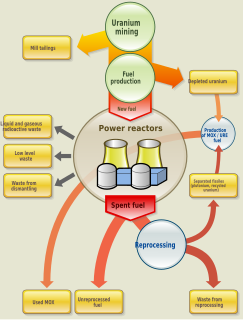
Nuclear fuel is material used in nuclear power stations to produce heat to power turbines. Heat is created when nuclear fuel undergoes nuclear fission.
The Chinese built Miniature Neutron Source reactor (MNSR) is a small and compact research reactor modeled on the Canadian HEU SLOWPOKE-2 design.
The Advanced CANDU reactor (ACR), or ACR-1000, is a Generation III+ nuclear reactor designed by Atomic Energy of Canada Limited (AECL). It combines features of the existing CANDU pressurised heavy water reactors (PHWR) with features of light-water cooled pressurized water reactors (PWR). From CANDU, it takes the heavy water moderator, which gives the design an improved neutron economy that allows it to burn a variety of fuels. However, it replaces the heavy water cooling loop with one containing conventional light water, greatly reducing costs. The name refers to its design power in the 1,000 MWe class, with the baseline around 1,200 MWe.

A reactor pressure vessel (RPV) in a nuclear power plant is the pressure vessel containing the nuclear reactor coolant, core shroud, and the reactor core.

Spent fuel pools (SFP) are storage pools for spent fuel from nuclear reactors. They are typically 40 or more feet (12 m) deep, with the bottom 14 feet equipped with storage racks designed to hold fuel assemblies removed from reactors. A reactor's local pool is specially designed for the reactor in which the fuel was used and is situated at the reactor site. Such pools are used for immediate "cooling" of the fuel rods, which allows short-lived isotopes to decay and thus reduce the ionising radiation emanating from the rods. The water cools the fuel and provides radiological protection shielding from their radiation.
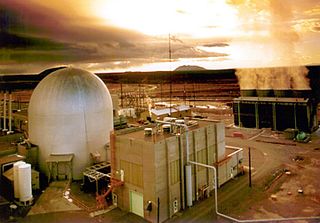
Experimental Breeder Reactor-II (EBR-II) is a sodium-cooled fast reactor designed, built and operated by Argonne National Laboratory at the National Reactor Testing Station in Idaho. It was shut down in 1994. Custody of the reactor was transferred to Idaho National Laboratory after its founding in 2005.

A nuclear reactor core is the portion of a nuclear reactor containing the nuclear fuel components where the nuclear reactions take place and the heat is generated. Typically, the fuel will be low-enriched uranium contained in thousands of individual fuel pins. The core also contains structural components, the means to both moderate the neutrons and control the reaction, and the means to transfer the heat from the fuel to where it is required, outside the core.

The McMaster Nuclear Reactor (MNR) is a 5MWth pool-type reactor located on the campus of McMaster University, in Hamilton, Ontario, Canada.
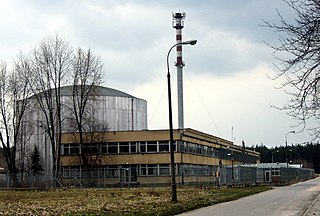
The Maria reactor is Poland's second nuclear research reactor and the only one still in use. It is located at Świerk-Otwock, near Warsaw and named in honor of Maria Skłodowska-Curie. It is the only reactor of Polish design.

The MIT Nuclear Research Reactor (MITR) serves the research purposes of the Massachusetts Institute of Technology. It is a tank-type 6 MW reactor that is moderated and cooled by light water and uses heavy water as a reflector. It is the second largest university based research reactor in the U.S. and has been in operation since 1958. It is the fourth-oldest operating reactor in the country.

The Omega West Reactor (OWR) was an experimental nuclear reactor located at Los Alamos National Laboratory in Los Alamos NM. OMR was completed in 1956 and primarily used for scientific scale nuclear research until it was fully decommissioned in 1994. It operated 24 hours a day, five days a week until 1972, when it went to eight hours a day, five days a week operation. The original purpose of the reactor was to collect nuclear material properties in support of the United States nuclear weapons program. Other uses included production of useful medical isotopes. The reactor was capable of producing an external beam of neutrons via beam tubes which extended through the reactor shielding. These were provided for external neutron beam experiments including: neutron radiography, neutron capture studies, gamma ray studies, neutron cross section measurements and neutron activation studies.

The hydrogen-moderated self-regulating nuclear power module (HPM), also referred to as the compact self-regulating transportable reactor (ComStar), is a new type of nuclear power reactor using hydride as a neutron moderator. The design is inherently safe, as the fuel and the neutron moderator is uranium hydride UH3, which is reduced at high temperatures (500–800 °C) to uranium and hydrogen. The gaseous hydrogen exits the core, being absorbed by hydrogen absorbing material such as depleted uranium, thus making it less critical. This means that with rising temperature the neutron moderation drops and the nuclear fission reaction in the core is dampened, leading to a lower core temperature. This means as more energy is taken out of the core the moderation rises and the fission process is stoked to produce more heat.

The Washington State University Reactor (WSUR) is housed in the Washington State University Nuclear Radiation Center (WSUNRC), and was completed in 1961. The (then) Washington State College Reactor was the brainchild of Harold W. Dodgen, a former researcher on the Manhattan Project where he earned his PhD from 1943 to 1946. He secured funding for the ambitious 'Reactor Project' from the National Science Foundation, the Atomic Energy Commission, and the College administration totaling $479,000. Dodgen's basis for constructing a reactor was that the College was primly located as a training facility for the Hanford site, as well as Idaho National Laboratory because there was no other research reactor in the West at that time. After completing the extensive application and design process with the help of contractors from General Electric they broke ground in August 1957 and the first criticality was achieved on March 7, 1961 at a power level of 1W. They gradually increased power over the next year to achieve their maximum licensed operating power of 100 kW.

FiR 1 was Finland's first nuclear reactor. It was a research reactor that was located in the Otaniemi campus area in the city of Espoo. The TRIGA Mark II reactor had a thermal power of 250 kilowatts. It started operation in 1962, and it was permanently shut down in 2015. At first, the reactor was operated by Helsinki University of Technology, and since 1971 by VTT Technical Research Centre of Finland.
